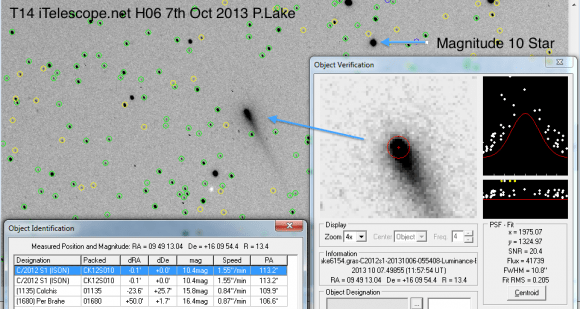As
we reported yesterday
, the latest data on Comet ISON indicates there is some encouraging news as far as the Comet surviving perihelion, its closest approach to the Sun. While some are all doom and gloom about the potential for Comet ISON putting on a good show, these latest images indicate that as of now, this comet is alive and doing well!
"We really do not know what comet ISON is going to do when it gets near the Sun," wrote astronomer Karl Battams of the
Comet ISON Observing Campaign website
. "But what we can say for certain, right now, is that comet ISON is doing just fine! It continues to behave like a fairly typical, if somewhat smaller-than-average, Oort Cloud comet. It has given no indication that it has fragmented and while such an event can never be ruled out, we see no evidence or hint that the comet is in any imminent danger of doing so. Any reports to the contrary are just speculation."
You can
read more from Battams
about the current status of ISON, but just take a look at some of these gorgeous latest images from a variety of astrophotographers:
[caption id="attachment_105442" align="aligncenter" width="580"]
Comet ISON on October 9, 2013, an 18-minute exposure from 10:22 - 10:43 U.T.. Credit and copyright: John Chumack. [/caption]
[caption id="attachment_105453" align="aligncenter" width="580"]
Comet ISON (top) passing above Mars This is a stack of 5 x 5 minute exposures. Credit and copyright: Alan Dyer/Amazing Sky Photography [/caption]
[caption id="attachment_105444" align="aligncenter" width="580"]
Comet ISON on October 7, 2013, imaged with a robotic iTelescope facility. Credit and copyright: Peter Lake. [/caption]
[caption id="attachment_105445" align="aligncenter" width="577"]
A 20-exposure stack of images from the 2-meter Liverpool Telescope. Credit and copyright: Ernesto Guido, Nick Howes and Martino Nicollini/Remanzacco Observatory. [/caption]
[caption id="attachment_105452" align="aligncenter" width="580"]
Comet ISON on October 4, 2013 as seen over Arizona, viewed with a 12.5" telescope, over an hour exposure time. Credit and copyright: Chris Schur. [/caption]
Keep checking
Universe Today's Flickr page
for more additions and the latest shots from around the world. You can also keep tabs on Comet ISON from
SpaceWeather.com's Comet ISON Realtime Gallery
. Better yet, try and see it for yourself! As of now, you'll need to find someone with a fairly good telescope, so check out your local amateur astronomy club or observatory and find out when they are planning on viewing ISON. And if the comet can hold itself together, we're all holding out hope that it will be visible with the naked eye after is passes by the Sun in late November.
Here's our detailed viewing guide from now until perihelion.
 Universe Today
Universe Today

